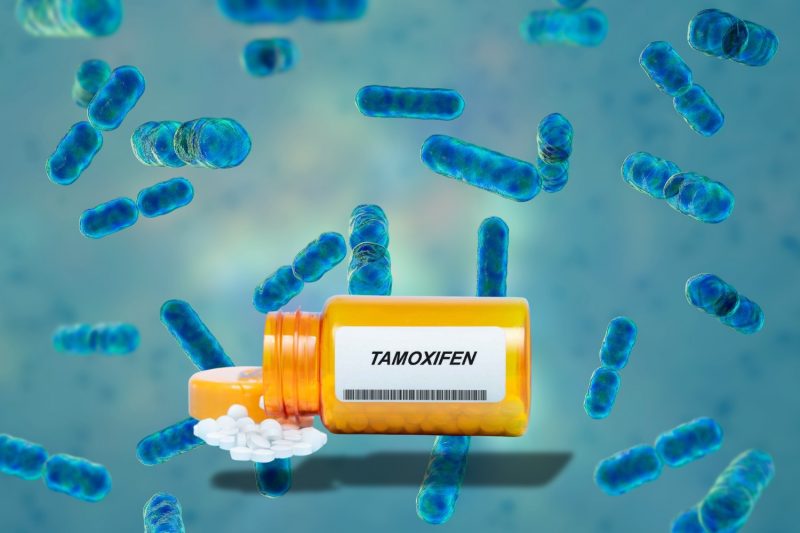Variations in the microbiota of the human gut impact on the pharmacokinetics of tamoxifen in the blood and consequently on the effectiveness of breast cancer prevention. The study, published in the journal mBio, 25 November, showed that the presence of the bacteria Bacteroides fragilis in the gut is linked to the ability of β-glucuronidase enzymes to recycle tamoxifen back into the blood.
“The significance of our research is in defining the role that gut microbes play in tamoxifen pharmacokinetics, thus paving the way for more tailored and effective therapeutic interventions in the prevention of breast cancer recurrence,” write the authors, led by Cholsoon Jang and Elizabeth Bess, from the University of California, Irvine.
Tamoxifen is the most prescribed orally administered oestrogen receptor antagonist used to prevent recurrence of hormone-dependent breast cancer and reduce the risk of primary breast cancer. Tamoxifen must be activated by metabolising enzymes in the liver; however, clinical studies show that neither genotype nor hepatic metabolic enzymes are sufficient to predict why some patients have sub-therapeutic levels of the drug in their blood. It is known that around 50% of women taking tamoxifen to suppress breast cancer recurrence are not effectively treated with the drug. The exact cause of this phenomenon has been unclear.
Bacteria in the gastrointestinal tract, recognised as a vital ‘metabolic organ’, are known to influence the accessibility and effectiveness of orally administered medicinal compounds. Since approximately 75% of tamoxifen is eliminated through bile into the gastrointestinal tract, Jang and Bess hypothesised that the variable effectiveness of tamoxifen across women was likely to be influenced by the gut microbiota.
First, the team provided tamoxifen to mice with no gut microbiome (gnotobiotic mice) and to mice with a human microbiome (introduced to the mice via human faecal samples). Results showed that mice with human gut bacteria had higher concentrations of tamoxifen in their blood stream versus mice with no gut bacteria. The role of gut bacteria in absorption of tamoxifen was supported by additional work showing that mice treated with antibiotics had lower tamoxifen peak levels in the blood than untreated mice.
When investigators compared the gut bacteria of mice treated with tamoxifen to mice treated with corn oil (control), using 16SrRNA gene amplicon analysis, they detected no differences in overall microbiota composition and abundance at the resolution afforded by 16SrRNA gene sequencing.
To identify the specific metabolism changes that take place upon exposure of gut microbes to tamoxifen, the team cultured faecal bacteria from five healthy human donors with a physiologically relevant dose (60 μM) of tamoxifen or corn oil (control). While the five cultured faecal bacterial samples showed similar metabolomic profiles in the absence of tamoxifen, the addition of tamoxifen resulted in variability of the metabolomic profiles across donors. For example, many putative metabolites were enriched in the presence of tamoxifen in donors 1–3 but not in donors 4 or 5. “Altogether, these tamoxifen-induced shifts in gut bacterial metabolomic profiles point to inter-individual variations in gut microbiome-tamoxifen interactions,” write the authors.
Since it is known that glucuronidation is a primary metabolic pathway for host metabolism of tamoxifen, the team decided to focus their investigation on the activity of the bacteria enzyme β-glucuronidases in faecal samples taken from nine different human donors. Functional assays of β-glucuronidase activity showed significant variability between samples in the hydrolysis of endoxifen glucuronide (END-G). The team went on to show that END-G hydrolysis was significantly and positively correlated with gene abundance of β-glucuronidase in the bacteria Bacteroides fragilis, which was measured using shotgun metagenomic sequencing.
The findings have led the team to propose a scheme where tamoxifen is initially absorbed into the portal circulation and transported to the liver, where it undergoes bioactivation by P450 enzymes to produce endoxifen (END), which then undergoes glucuronidation leading to the formation of endoxifen glucuronide (END-G). Approximately 75% of END-G is excreted in the bile to the small intestine, where END-G then requires hydrolysis by the enzyme β-glucuronidase (derived from Bacteroides fragilis) before it can be reabsorbed into the systemic circulation and exert its anti-cancer effects.
“Initially, we thought that differences in each person’s unique microbiome might explain why people respond differently to tamoxifen, but we didn’t actually find big differences in the types or amounts of bacteria across people,” graduate student Yasmine Alam and the study’s first author tells Cancerworld. “Finer resolution showed that the individual differences were instead due to differences in certain enzymes produced by gut bacteria, called β-glucuronidase, that play a role in how tamoxifen is broken down. The levels of the bacteria appear uniform across patients, it is the individual ability of the bacteria to produce the enzyme that determines the level of tamoxifen.”
The team believe that oncologists could eventually use their results to personalise treatment for cancer patients. “Based on what we’ve found so far, it seems that the gut microbiome could play a key role in controlling levels of tamoxifen in the body, which might be important for predicting how well a patient will respond to treatment,” says Alam. “Looking ahead, it would be helpful to figure out exactly which bacteria are interacting with tamoxifen and whether certain foods could encourage the growth of these helpful bacteria and stimulate the production of the enzyme. This could lead to dietary recommendations for patients on tamoxifen to help improve the drug’s effectiveness.”












